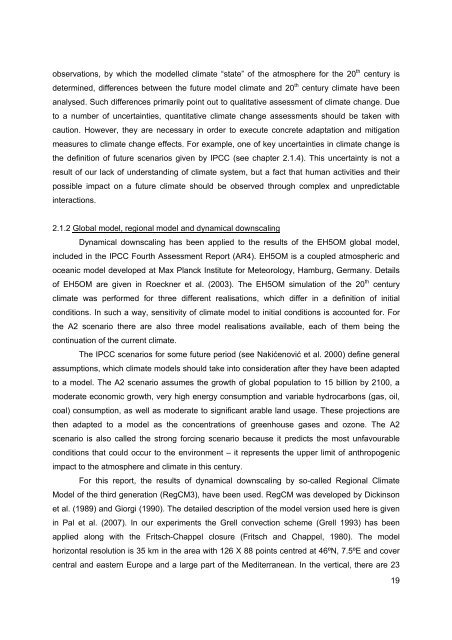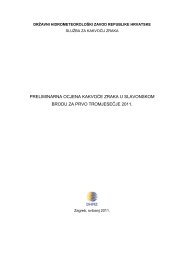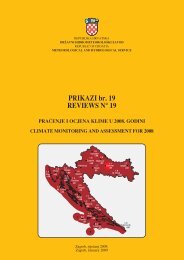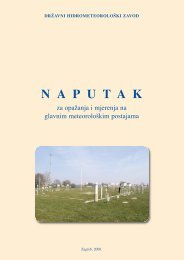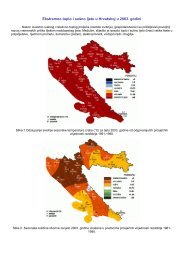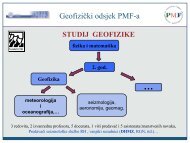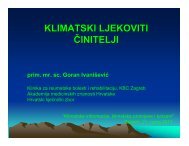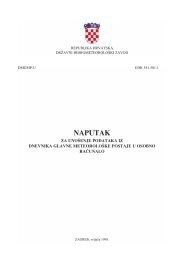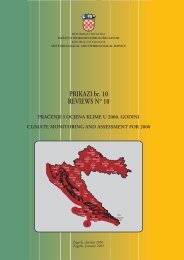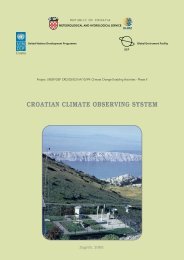Observed climate changes in Croatia Climate change scenario
Observed climate changes in Croatia Climate change scenario
Observed climate changes in Croatia Climate change scenario
You also want an ePaper? Increase the reach of your titles
YUMPU automatically turns print PDFs into web optimized ePapers that Google loves.
observations, by which the modelled <strong>climate</strong> “state” of the atmosphere for the 20 th century is<br />
determ<strong>in</strong>ed, differences between the future model <strong>climate</strong> and 20 th century <strong>climate</strong> have been<br />
analysed. Such differences primarily po<strong>in</strong>t out to qualitative assessment of <strong>climate</strong> <strong>change</strong>. Due<br />
to a number of uncerta<strong>in</strong>ties, quantitative <strong>climate</strong> <strong>change</strong> assessments should be taken with<br />
caution. However, they are necessary <strong>in</strong> order to execute concrete adaptation and mitigation<br />
measures to <strong>climate</strong> <strong>change</strong> effects. For example, one of key uncerta<strong>in</strong>ties <strong>in</strong> <strong>climate</strong> <strong>change</strong> is<br />
the def<strong>in</strong>ition of future <strong>scenario</strong>s given by IPCC (see chapter 2.1.4). This uncerta<strong>in</strong>ty is not a<br />
result of our lack of understand<strong>in</strong>g of <strong>climate</strong> system, but a fact that human activities and their<br />
possible impact on a future <strong>climate</strong> should be observed through complex and unpredictable<br />
<strong>in</strong>teractions.<br />
2.1.2 Global model, regional model and dynamical downscal<strong>in</strong>g<br />
Dynamical downscal<strong>in</strong>g has been applied to the results of the EH5OM global model,<br />
<strong>in</strong>cluded <strong>in</strong> the IPCC Fourth Assessment Report (AR4). EH5OM is a coupled atmospheric and<br />
oceanic model developed at Max Planck Institute for Meteorology, Hamburg, Germany. Details<br />
of EH5OM are given <strong>in</strong> Roeckner et al. (2003). The EH5OM simulation of the 20 th century<br />
<strong>climate</strong> was performed for three different realisations, which differ <strong>in</strong> a def<strong>in</strong>ition of <strong>in</strong>itial<br />
conditions. In such a way, sensitivity of <strong>climate</strong> model to <strong>in</strong>itial conditions is accounted for. For<br />
the A2 <strong>scenario</strong> there are also three model realisations available, each of them be<strong>in</strong>g the<br />
cont<strong>in</strong>uation of the current <strong>climate</strong>.<br />
The IPCC <strong>scenario</strong>s for some future period (see Nakićenović et al. 2000) def<strong>in</strong>e general<br />
assumptions, which <strong>climate</strong> models should take <strong>in</strong>to consideration after they have been adapted<br />
to a model. The A2 <strong>scenario</strong> assumes the growth of global population to 15 billion by 2100, a<br />
moderate economic growth, very high energy consumption and variable hydrocarbons (gas, oil,<br />
coal) consumption, as well as moderate to significant arable land usage. These projections are<br />
then adapted to a model as the concentrations of greenhouse gases and ozone. The A2<br />
<strong>scenario</strong> is also called the strong forc<strong>in</strong>g <strong>scenario</strong> because it predicts the most unfavourable<br />
conditions that could occur to the environment – it represents the upper limit of anthropogenic<br />
impact to the atmosphere and <strong>climate</strong> <strong>in</strong> this century.<br />
For this report, the results of dynamical downscal<strong>in</strong>g by so-called Regional <strong>Climate</strong><br />
Model of the third generation (RegCM3), have been used. RegCM was developed by Dick<strong>in</strong>son<br />
et al. (1989) and Giorgi (1990). The detailed description of the model version used here is given<br />
<strong>in</strong> Pal et al. (2007). In our experiments the Grell convection scheme (Grell 1993) has been<br />
applied along with the Fritsch-Chappel closure (Fritsch and Chappel, 1980). The model<br />
horizontal resolution is 35 km <strong>in</strong> the area with 126 X 88 po<strong>in</strong>ts centred at 46ºN, 7.5ºE and cover<br />
central and eastern Europe and a large part of the Mediterranean. In the vertical, there are 23<br />
19


